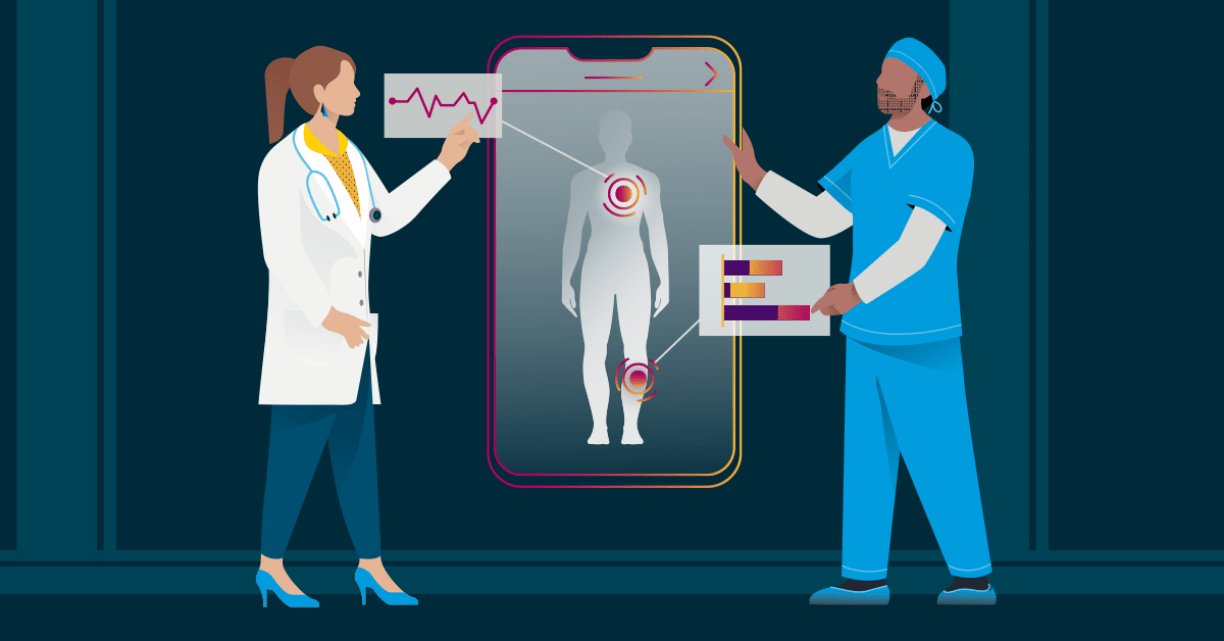This website is intended for healthcare professionals only.
Explore industry leaders’ perspectives on key insights and findings from “Beyond Intervention” primary research. Read their vision for the future of vascular care:
We recently published our report on the current and future needs of the healthcare ecosystem, “Beyond Intervention: Personalized Vascular Care Through Technological Innovation.”1 This paper, based on an extensive worldwide survey of physicians, administrators and patients, emphasizes the importance of all stakeholders taking a view of the whole patient, going beyond the examination or treatment room, beyond any single point of contact with healthcare provision and leveraging data-driven technology to fuel both better treatment outcomes and an improved quality of life for patients.2
In order to make an effective diagnosis and treatment plan for patients with cardiovascular diseases (CVD), it’s essential that physicians and administrators “connect the dots” across the entire vascular care continuum, and such capability clearly relies heavily upon providers’ ability to gather, integrate and interpret a wide range of data generated from many different sources.
However, while technological advances have improved physicians’ ability to make a diagnosis and initiate a therapeutic plan, persistent data gaps continue to blunt their full potential. According to patient respondents in our survey, those gaps include “a lack of data on patients similar to themselves”, and the sense that their doctors fail to leverage rapidly-evolving technologies to communicate and share data in an effective and impactful fashion with other doctors and specialists. As a result, data-driven insights often fall short of delivering truly personalized care: 63% of patients in our survey said they were concerned about “not having a relationship with a doctor who knows my whole health history and my family’s history.”
To plug such data gaps in the healthcare system, physicians and administrators must resolve another key issue: earning patients’ trust that their personal data are protected. Our survey showed that patients are increasingly wary about personal data protection: 23% of patient respondents agreed/strongly agreed with the statement “I don’t want my information shared, even if it’s private”, despite the majority (>90%) acknowledging that data sharing was beneficial not only for their own tailored care, but also for the care of others in the future.3

One thing is certain: the volume of healthcare data will continue to grow exponentially: according to an International Data Corporation report sponsored by Seagate Technology, healthcare data will experience a 36% compound annual growth rate (CAGR) through 2025 – eclipsing the data growth rates of industries such as manufacturing, financial services, and the media.4
Such a torrent of data is being driven by an ever-expanding array of sometimes non-traditional sources – big data analytics tools, medical imaging technologies and real-time data to assist with clinical decision-making, as well as by wearables, social media, electronic health records (EHRs), smartphones, cars, smart TVs and even home appliances such as smart refrigerators. The increasing popularity of chatbots and virtual assistants is sure to trigger even more healthcare information traffic to increase the data burden.
For healthcare providers looking to tame this data deluge, artificial intelligence (AI) could provide the ultimate solution: in the healthcare space, AI has been called “the ideal population tool” based on its ability to enable comparisons of individual cases with results from much broader populations, to help providers identify individuals at greater or lesser risk of developing chronic diseases or related complications, to tailor preventive therapies, and to allocate limited resources to those most likely to benefit from them.5
AI has the ability to synthesize, assimilate and integrate genetic, environmental and lifestyle data from a wide variety of sources with more traditional healthcare metrics to create models that can predict the trajectory of both health and disease6, and in turn determine the best candidates for specific treatments.
Patients don’t all look the same. Technology like AI helps compare individual cases with results from much broader populations, making it the “ideal population tool”.
AI can especially assist beleaguered physicians struggling to spend more time with patients and discern data insights relevant to each patient, and AI-driven advances in unsupervised learning could lead to better treatment selection and better outcomes, whilst simultaneously removing the tedium from everyday clinical practices by automating tasks, such as interacting with EHRs and billing on a manual basis.
Before healthcare organizations can harness AI to help fill data gaps, they must first address skills gaps related to AI. This can be accomplished not only by hiring AI researchers, software developers and data scientists, but also by training the existing workforce to fill new roles created by the rise of AI. In our survey, 39% of physicians and 37% of administrators globally named “industry training” as an underutilized resource that could assist in improving patient throughput and staff workflow.
Much like data sharing, whilst AI has the potential to deliver a host of benefits, healthcare providers must also carefully consider associated ethical concerns. These include privacy controls pertaining to data collection (an issue that has arisen in connection with COVID-19 contact tracing) and the potential for bias/discrimination built into underlying data sets, which can taint decision-making.
The latter problem can be at least partially alleviated by hiring a diverse workforce, which has been demonstrated to reduce the potential for inherent and often unconscious bias.

Above all, our recent study highlights how utilization of the latest data-driven technologies can increase visibility into patient care, allowing physicians to create personalized treatment plans that promote better patient outcomes and improved quality of life.
According to our surveyed physicians and administrators, data-driven technologies are already enhancing patient care by enabling: more accurate diagnoses, earlier identification of co-morbidities, a better understanding of patients’ risk factors, more patient involvement in their own health through digital devices and wearables, which in turn result in a higher level of personalized care and the ability to track outcomes, from diagnosis to aftercare. As a result, vascular patients enjoy better outcomes, including a lessened need for further intervention and reduced hospital readmissions and costs.
To ensure healthcare accessibility for all populations, including the poor and underserved, technology companies must place greater emphasis on developing solutions optimized to reach them. A truly inclusive approach needs to extend beyond technology itself. “Many make the mistake that it’s just about investing in technology,” Maneesh Juneja explained. “The reality is that people, process and policy have to move in tandem in order for the benefits of new technology to be fully realized.”
By improving insights across a patient’s entire care journey, data-driven decision-making enables a new level of personalized care – from understanding risk factors and co-morbidities, to providing precise diagnoses, to making the right treatment decisions at the right time, to ensuring post-treatment plan adherence. The cornerstone of such a healthcare future is data, providing the roadmap each step of the way.
References
